Freelap USA: After our recent articles about flywheel training with the kBox device, we were overwhelmed with your feedback. So we asked Exxentric Co-founder M.D. Fredrik Correa to tell us all about it — how it works, its history and the training methods that come with it. Here is his story.
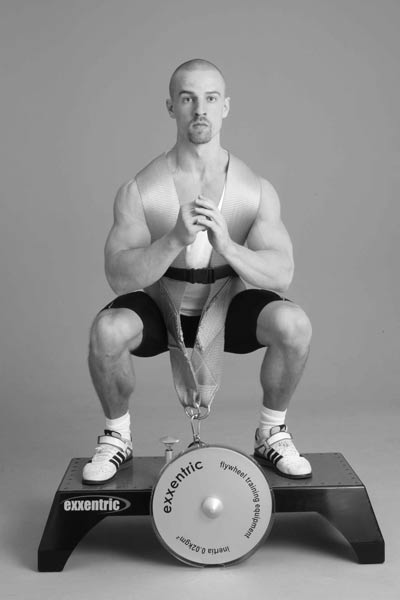
An athlete doing a squat exercise on the kBox 2.0
By Fredrik Correa, M.D., B.Sc. Sports, founder of Exxentric
Have you heard or read about the strength training devices that work in zero-gravity? Or have you seen pictures of an elite soccer team with players standing on boxes with some kind of harness pulling and going up and down just before they disconnect and rush down the field? Maybe you have read the articles written by Chris Korfist “My Love Affair with the Bulgarian Split Squat” and “Epic Speed Training” about the kind of strength training device that they endorsed for sprint training?
If you recognize this, you have probably been exposed to the kBox from Exxentric. kBox is short for kinetic Box, which is a flywheel training device. You might think that flywheel training is new, but it’s quite the opposite. It has just lately become more widely used and recognized for its benefits like motion freedom, eccentric overload and variable resistance and unlimited load.
Our History of Flywheel Training
As far as I know, the first study related to flywheel resistance training was conducted at the Laboratory for the Physiology of Gymnastics, University of Copenhagen in 1924, by researchers Hansen and Lindhard (1). They used a flywheel made out of lead and steel to do what all decent muscle physiologists do while no one is watching: measuring force curves during biceps contraction. They do, however, refer to a stationary bike using a flywheel for resistance in a study conducted in 1913 by a colleague from the same institution, Prof. August Krogh. He is probably the father of using the flywheel in training (2). Krogh, by the way, received the Nobel Prize in 1920 for his work on the function of capillaries. This is, however, not the first documented flywheel device. The Gymnasticon, a flywheel device invented in 1796 by a Frenchman, Francis Lowndes, was way before that. I think we can agree that flywheel training has been around for quite some time now.
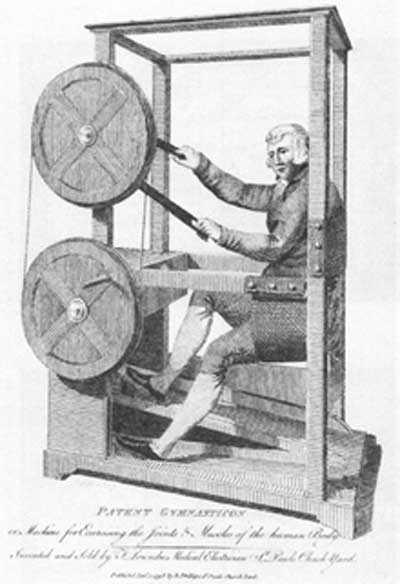
Gymnasticon. From Wikipedia.
Since those early days the flywheel has been used in many mechanical applications for the purpose of accumulating kinetic energy, just to re-surface in resistance training in 1994. Back then, many people within the scientific exercise physiology community were trying to solve the problem with atrophy and bone loss in microgravity, i.e. space travel. Steroids, electro stimulation, rubber bands and hydraulics had been tried, but all failed in one way or another. But then, in 1994, two Swedish scientists published a study (3) in which they had designed a flywheel leg extension. They conducted a number of studies in the years after and developed a couple of flywheel resistance training devices similar to traditional strength training devices, like leg curl, leg extension and so on, but with the weight stack replaced by a flywheel.
COACHING FRUSTRATION. This was when I first found out about flywheel training. I had just finished my studies at the Swedish School of Health and Sport Sciences in Stockholm where I also met my friend and co-founder of Exxentric, Marten Fredriksson. At that time, we were both working in the same ice hockey club, training elite junior players. I coached 16-17 year-olds and Marten 18-19 year-olds. We had a lot of discussions about the talented players from different local teams that got recruited into our club in the early junior years. The problem was that they didn’t have any schooling in training, especially regarding the use of free weights. We felt that we spent a lot of time during their four junior years teaching them how to lift instead of improving their physique and performance to the extent that had been possible if they had been better lifters. Since they were strong and able kids it was frustrating that we couldn’t put enough load on them, since their lack of technique didn’t allow it.
IN THE RESEARCH LAB. Shortly after I found out about the flywheel devices I started working on some projects in the lab with the researchers developing those. This was in the Muscle and Exercise Physiology Laboratory at the Karolinska Institute. When I was in the lab working on an electromyography (EMG) project related to the traditional flywheel devices, I saw a prototype device made by an engineer named Hakan Eriksson. He worked for the department of Biomedical Engineering at the Karolinska Hospital, just across the road. He was helping the researchers to build all prototypes, but he was also a dedicated ice skater. To solve his problem with off-ice training he had built a prototype device consisting of a shaft with a flywheel on a small plate. He used it for high rep, half squats with low inertia trying to mimic the metabolic work in skating.

First prototype of the kBox.
BUILDING A PROTOTYPE. I felt that Hakan’s prototype could provide the basis for a completely new product. So, Mårten and I got together in the lab and discussed the possibility of building a flywheel multi-exercise device based on the prototype, but with more motion freedom. We wanted it to work in a similar fashion as free weights, but use a flywheel for resistance instead. We pitched the idea with some sketches to the research leader, and he liked the idea and we started developing our baby.
We started by increasing the height of the box to get the shaft lower to increase the depth in the squat. We increased the area on top to allow more lateral movements and a longer shaft for fitting more flywheels, and so on. When the product was ready, we had put in a countless more hours into this than we had ever imagined.
The prototype was working but far from complete, and many improvements still had to be made. However, the lead researcher and his company took a shorter-term perspective and decided to release the prototype as a product into the market. After the release we received considerable feedback consistent with our own thoughts on how to improve the device further and also new ideas.

Exxentric kBox v1.0.
FOUNDING EXXENTRIC. After our time in the research lab, Marten and I went separate ways. I had my hands full with medical school and graduated from Karolinska Institute in 2006. But we knew that we had started the project to fill the gap for athletes and patients and realized it could be done so much better – it had to be.
Over the years, Marten and I discussed realizing our ideas and suddenly we bumped into Kjell Insulander, who was a producer and a subcontractor of metal parts to other companies. He had an interest in training and also to build a product of his own. So we decided to found Exxentric and started phase two. With our ideas and Kjell’s engineering skills, we could release our next-generation flywheel training device, the kBox 1.0 in 2011.
A small batch of the first kBox version sold out pretty fast to high profile customers, making us realize that we needed an experienced manager to handle future growth. We found one in Erik Lindberg who, prior to Exxentric, had held a wide range of management positions in multi-national companies like Apple and Lexmark. Erik is our CEO since a couple of years, overseeing all aspects of our business expansion around the world. After a period of fast growth, Exxentric is now releasing the third version of our main product, the kBox 3. We have come very far from where we started. The new device offers superior functionality, better looks, much lower weight and a better build quality. We are convinced that we are on the right path, and you should expect to see exciting product news coming from us in the future.
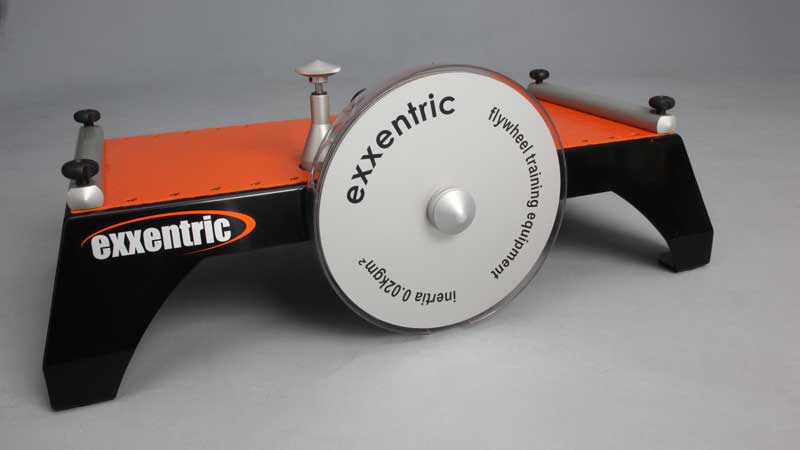
Exxentric kBox v2.0.
The Flywheel Principle and its Benefits
The principle is basically the same for all different kinds of flywheel training devices, but I will use the kBox as an example. One or more flywheels get attached to the end of the shaft. Some strap, rope or wire is attached to the shaft. By rotating the flywheel and shaft a few revolutions, you will get some strap rolled up on the shaft, which is needed before training can start.
When you pull the strap by applying a concentric muscle action, the shaft will be subjected to a force, which will accelerate the rotation of the flywheel. When the strap is fully pulled out, the continued rotation of the flywheel will instead lead to the retraction of the strap. You will, therefore, have to apply an eccentric muscle force to decelerate the rotation of the flywheel. When the flywheel stops, you apply concentric muscle action again, and the movement starts again. Concentric and eccentric. As easy as that.
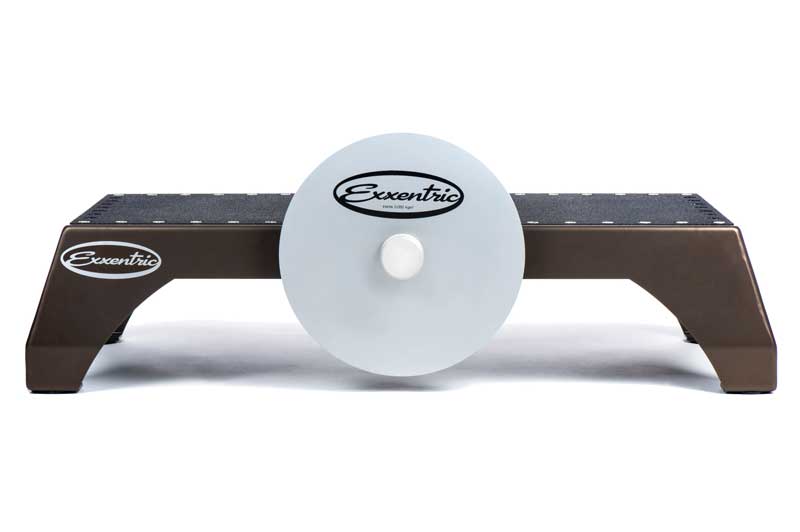
kBox 3. Released December 2014.
UNLIMITED LOAD. The amount of force that will have to be applied to get a certain acceleration depends on the inertia of the flywheels. One of the fundamental laws of physics is that all bodies resist being rotated. In other words, in order to accelerate or decelerate a rotation you must apply force.
The beauty of flywheels is that they can always be accelerated a little more, which means the potential load is unlimited. The harder you pull, the harder it gets. All energy that you put into the flywheel during the concentric phase, you will have to brake in the eccentric phase. The kBox shows no mercy here; it will gladly try to pull you all the way through the machine and down to the floor (luckily, in reality it is equipped with a bumper to prevent that from happening).
FREEDOM OF MOTION. With a multi-exercise flywheel device like the Exxentric kBox, you also have a higher degree of motion freedom. Since the force is applied through the strap to the shaft, you can work out in lateral movements if you like, for example by doing lateral squats. Doing this type of exercise with loads in the neighborhood of your 1 RM squats is very hard, if not impossible, with other exercises or equipment. There is a Spanish study looking at this right now, so stay tuned for those results, expected later this winter.
I don’t yet know for sure, but I can bet you that flywheel squats improve jump height more and lateral squats improve speed in change of direction more than using traditional tools. So now you know where you heard it first! You can also use this unique motion freedom in other exercises, like for example rowing, shoulder and core exercises.
MAX LOAD IN EVERY REP. With flywheel training, the load is also variable so you will get max force output in every rep in a maximal set. A maximal set on the kBox can be compared with a drop set with coupled 1 RMs, every rep down until you quit (see graph). This is one key factor in the fast and significant hypertrophy seen early in a high-intensity flywheel training program (4).
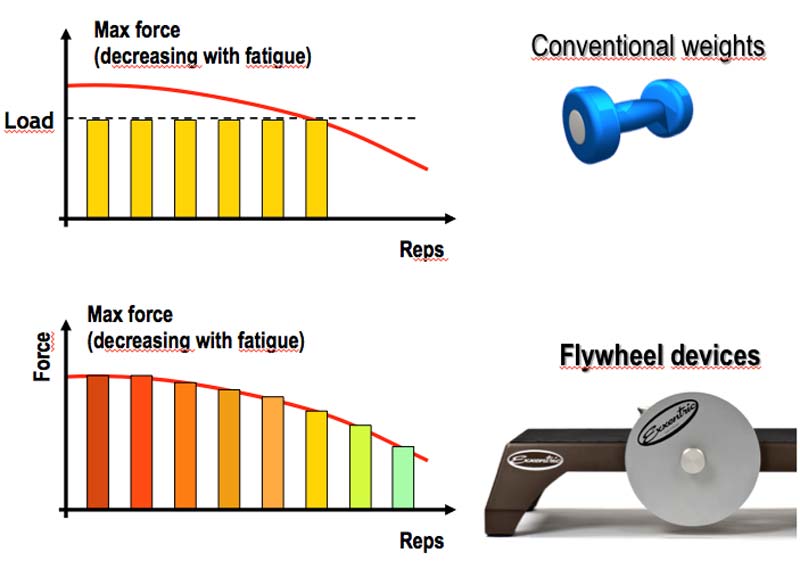
The variable resistance also allows individuals with differences in strength to work out together, or for the same person to do warm-up and training using the same inertia. Less time spent shifting weights, in other words.
If you have you ever done a leg session with free weights together with someone of different strength and height, you know what I mean. You probably spent about ¾ of the session loading and unloading the bar. Shifting from the heavy barbell back squat to deadlift, unloading the bar just to put it down and then load it again is personally one of my best reasons to do this on the kBox instead.
ISOINERTIAL RESISTANCE. Another effect of the variable resistance is that the lever in the motion doesn’t matter anymore. Instead, you get the same resistance during the whole exercise. This effect gives high muscle tension all through the motion, isoinertia, which can also explain why in studies you can see strength gains in all angles during the motion compared to free weights where you get the highest gains in a certain angle (5).
ECCENTRIC OVERLOAD. By eccentric training people often refer to a longer time under tension with traditional weights and advocate a slower eccentric phase. This is good in one way, since the eccentric force will be a little higher if you go slowly with weights.
The difference with flywheel is that you can induce a lot of kinetic energy during the concentric phase, but choose to resist during only a part of the eccentric phase. Thereby the muscle must elicit a much higher eccentric force and trigger gains in strength and hypertrophy. This kind of eccentric workout is referred to as eccentric overload, i.e. loads > 1 RM concentric.
Eccentric forces of these magnitudes are unnecessarily complicated to obtain in traditional exercises since you need assistance, for example, in the form of forced negatives or supramaximal loads. Another way is by doing lateral overload using both legs up and one leg down, but then you are rather restricted to weight stack machines and probably pretty far away from how you want to perform in the field or on the track.
With a flywheel device like the kBox, you can easily overload with 100% if you like and still work out in an easy, efficient and safe way. Here is a flywheel introduction video with an earlier kBox version so you can see how this works.
More about the practical methods later, now it’s time for some science. The question is if scientific studies back this up? I’ll show you how.
Scientific Support of Flywheel Training
Several studies have shown flywheel devices to give an earlier and higher degree of hypertrophy and strength gains, both concentric and eccentric strength, compared to traditional weights (4-6). Also, in comparison to squats, exercises using flywheel devices have shown to produce a higher degree of muscle activation and effect of training (7).
As mentioned above, you can also see strength gains in all angles to a higher degree in flywheel training compared to traditional weight training (6). From this I would like to think that the kBox works both in the basic strength training program where you want to build mass and strength in all angles and also in more specific, performance training, where every percentage in effect counts.
Sometimes these percentages can make a huge difference, for example in a fresh Spanish study comparing PAP (post-activation potentiation) using barbell and flywheel lunges before swim starts (8). Flywheel PAP increased average speed after start with 35% compared to warm-up only and 18% compared to barbell lunges. This gave a significant time advantage even after a 15 m swim which, of course, is a huge advantage in a short swimming event.
Eccentric overload might be perceived as a bit unhealthy to some, but those who have studied strength training and muscle physiology know that the skeletal muscle is about 30% stronger in the eccentric phase. Hence, we are in a way built for this already.
Another interesting thing is that there is no force-velocity relationship like in the concentric phase; therefore, you can produce a maximal eccentric force even at high eccentric speeds and therefore mimic your performance in a much more similar way working in high angular velocity.
Eccentric training gives a higher effect on muscle mass and strength compared to strict concentric training. That has been known for quite some time and well accepted (9, 10). But eccentric overload gives even higher gains than traditional concentric-eccentric training, especially in trained subjects if you look at performance and not only gains in strength (11).
It is nice if your athletes are getting stronger, for sure, but if they don’t improve their performance, it is basically a waste of time. You’re not going to decide the winner in the next game with your 1 RM squat, unless you are a powerlifter. For all us doing sports including balls, pucks, rackets, running and jumping it is all about tackles, breakaways, change of direction, jump height and length that counts.
Eccentric training has also shown increased muscle length, both in fascicle length and range of motion (12), fiber transformation into a faster phenotype, type IXIA (13), and improved balance and stiffness in tendons, where the latter gives giving a higher efficacy in the stretch-shortening cycle (14).
Eccentric training also gives protection from future delayed onset of muscle soreness (DOMS) by triggering a higher degree of tissue damage and inflammatory response. But thanks to that you also get a preventive effect from future damage, beside the effects mentioned earlier in performance and strength (15, 16, 17). With repeated eccentric workouts, the effect with more DOMS is attenuated and you can even get this effect without getting DOMS at all is you start with a low dose eccentric training and increase gradually (13).
Older people get a higher training effect after recovery but also a higher degree of inflammation after eccentric workouts (13). A rather new Swedish study from the Karolinska Institute published in 2014 also showed that females had about the same degree of hypertrophy, strength and power gains as the male subjects when doing flywheel training (14).
The kBox is not all about eccentric training, but it makes it so much easier that you won’t understand how you managed to do your eccentrics before. Being able to do heavy eccentric workout by yourself without relying on assistance, and where you can change the eccentric load or overload from repetition to repetition is a great tool in your and your athletes’ training.
Further on, the harness that you use with the kBox in most leg exercises offers some advantages. It unloads the lower back and for taller athletes like for example basketball players, who even with a good technique get a long lever and high torque on the lower back. Users with previous back problems can usually work out harder without getting sore. Also, those with a poor technique that limits them with a barbell can work out safer and harder. By using the kBox in parallel to barbell training you can build strength and technique at the same time, not wasting any time like we did with our hockey juniors.
Flywheel Methods for Eccentric Overload
I could probably write a book about all the methods to overload the eccentric phase with the kBox, but here is a summary.
The easiest way to overload is what we call delayed eccentric action. This means that you pull all the way through the concentric phase but in the start of the eccentric action you don’t resist the flywheel but you let it pull you down. When you get a bit into the eccentric action you start resisting, and for the concentric and eccentric energy to add up – and for you to stop and turn the flywheel – you have to brake much harder since you do it in a shorter time.
There are heavier variations of this that we call the impulse overload where you quickly go down in the eccentric phase and position yourself where you want the flywheel to ”hit you”. When the flywheel has retracted the strap, the rotational energy will hit you in that position forcing you to go from unloaded to overloaded in fractions of a second demanding a high eccentric force and power output.
Further on you can do lateral overload where you go bilateral in the concentric phase and unilateral in the eccentric. This is useful if you want to go explosive with low inertia in the concentric phase but still get a nice eccentric load on the way down. Overloaded concentric action is another benefit of the variable resistance. By using lower limb to put in extra kinetic energy in the flywheel during the concentric phase but only using the primary muscle (upper body) in the eccentric phase you easily get a supramaximal load in the eccentric phase.
Combining some of these methods can give you a high degree of overload in the eccentric phase and a long time under tension at the same time. Our friend Andy Baxter, an American world class rower and an omnipotent idea guy in all aspects of training, invented one combination. He named it Concentric loaded acceleration cycles (CLAC), and we have stuck with that name. CLAC will probably be your worst or best training experience, depending on how you like it, but training will never be the same afterward.
With CLAC’s you start with a maximally overloaded concentric action followed by an overloaded eccentric phase. At the end of the eccentric phase, you turn the flywheel and go all out concentric again. In the last eccentric phase, you get a tiny rest on the way down to the position before the next overloaded concentric action. In this setting you will have maximal or supramaximal force output and tension during the first concentric-eccentric, and the subsequent concentric phase after that with a time under tension that will feel like an eternity in rep number 3, I promise you.
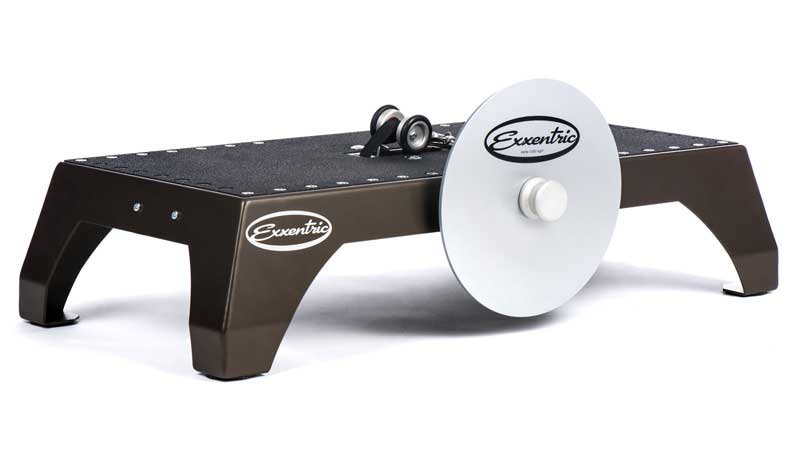
Exentric kBox 3
Encouraging User Feedback
The testimonials we get is that the users get really nice results both in terms of strength and performance, and this can be backed up with a decent volume of scientific studies.
The equipment weighs about 50 lbs. (23 kg) total. It is highly mobile and completely silent and opens up many opportunities for coaches working with their athletes in the field, on trips, games away or at home during rehab or time of from the team.
Users appreciate the motion freedom and the exercises they only can do with the kBox. The safety and less dependence on technique with the harness is for many the main factor. In the rehabilitation in many high-performance sports where, for example, a broken hand makes it impossible for a hockey player to work out with heavy barbells, but he or she can still do heavy lifting on the kBox.
In training of the elderly, the functionality of the kBox squat is quite a revolution since putting them under a barbell has been out of the question if they didn’t have any previous experience with this. Some might argue that they can’t do the Olympic lifts on the kBox, but that is not an issue for us. We don’t see it as working with the kBox or traditional weights or bars; it is up to the experienced coach to figure out what equipment to use for his purposes and I can’t really see how having a larger toolbox would compromise any athlete’s development and results. Do you?
Thanks for reading my story. I’d love to answer any questions or comments you have. You can reach me anytime via Twitter @FredrikCorrea or through our website exxentric.com. Also, please feel free to reach out to us on our Facebook page.
Please share this article so others may benefit.
[mashshare]
About the Author
Fredrik Correa is a Swedish physiologist, entrepreneur, former ice hockey coach and a co-founder of Exxentric, developers of the kBox.
After a short journey at the Royal Institute of Technology in Stockholm, Fredrik studied Sports Science at the Swedish School of Sports and Health Science in Stockholm (GIH) with the focus on ice hockey. He has worked as an ice hockey coach for 15 years in different clubs and for The Swedish Ice Hockey Federation.
Further studies in physiology and several projects in exercise physiology at The Karolinska Institute led him to medical studies at Karolinska and he graduated in 2006 and has worked as a physician since.
Fredrik is now a M.D, has BSc in Sports and is a resident physician at Danderyd Hospital Stockholm.
References
1. Hansen T.E, Lindhard, J. On the maximal work of human muscles especially the flexors of the elbow. 1924. Laboratory for the Physiology of Gymnastics, University of Copenhagen.
2. Krogh, A. Skand. A bicycle ergoemter and respiration apparatus for the experimental stuy of muscle work. Arch. Physiol. 1913; 33:375-395.
3. Berg, HE, Tesch A. A gravity-independent ergometer to be used for resistance training in space. Aviat Space Environ Med. 1994 aug;65(8):752-6.
4. Seynnes O.R., de Boer M., Narici, M.V. Early skeletal muscle hypertrophy and architectural changes in response to high-intensity resistance training. J Appl Physiol (2007)102;368-373.
5. Norrbrand L., Pozzo M., Tesch PA. Flywheel resistance training calls for greater eccentric muscle activation than weight training. Eur J Appl Physiol (2010) 110:997-1005.
6. Norrbrand et al. Resistance training using eccentric overload induces early adaption in skeletal muscle size. Eur J Appl Physiol 2008;102(3):271-281.
7. Norrbrand et al. Quadriceps muscle use in the flywheel and barbell squat. Aviat Space Environ Med. 2011 jan;82(1):13-9.
8. Cuence-Fernández, F. et al. Effect on swimming start performance of two types of activation protocols: Lunge and YoYo Squat. J Strength Cond Res. 2014 sep 15 [epub ahead of print].
9. Dudley et al. Importance of eccentric actions in performance adaptions to resistance training. Aviat Space Environ Med. 1991; 62: 543-50.
10. Roig et al. The effects of eccentric versus concentric resistance training on muscle strength and mass in healthy adults: a systematic review with meta-analysis. Br J sports Med 2009; 43:556-568.
11. English, KL et al. Early-phase musculoskeletal adaptations to different levels of eccentric resistance after 8 weeks of lower body training. Eur J Appl Physiol 2014 July 22. Epub ahead of print.
12. O’Sullivan, K. The effects of eccentric training on lower limb flexibility: a systematic review. Br J Sports Med 2012;46:838-845.
13. Friedmann-Bette, B. Effects of strength training with eccentric overload on muscle adaptation in male athletes. Eur J Appl Physiol (2010) 108:821-836.
14. Onambélé, G. et al. Neuromuscular and balance responses to flywheel inertial vs. weight training in older persons. J Biomech (2008)41:3133-3138.
15. Neme et al. Time course of muscle damage and inflammatory Reponses to resistance training with eccentric overload in trained individuals. Med Infl. Vol 2013.
16. Gault, ML, Willems, M.E.T. Aging, functional capacity and eccentric exercise training. Ag Disease 2013;4(6):351-363.
17. Fernandez-Gonzalo, R. et al. Muscle damage responses and adaptions to eccentric-overload resistance exercise in men and women. Eur J Appl Physiol (2014) 114:1075-1084.

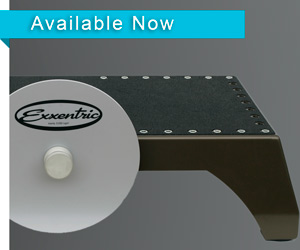

Where can you get one of these and how much do they cost?
See the original flywheel devices http://www.nhance.se
I have/had both. kBox is superior in ability to change weight and feels much more alive.
Might be, I have used both too, no problems with yoyo, very solid movement and consistency compared to another “copy” from Desmotec Italy. Though almost all of the scientific studies are made by using nhance yoyo devices.
This device would be much cooler if the flywheel conducted electricity and it charged your phone while working out.